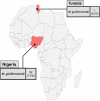Meyerozyma guilliermondii species complex: review of current epidemiology, antifungal resistance, and mechanisms
- PMID: 36306113
- PMCID: PMC9679122
- DOI: 10.1007/s42770-022-00813-2
Meyerozyma guilliermondii species complex: review of current epidemiology, antifungal resistance, and mechanisms
Abstract
Meyerozyma guilliermondii has been accepted as a complex composed of Meyerozyma guilliermondii, Meyerozyma carpophila, and Meyerozyma caribbica. M. guilliermondii is a saprophyte detected on human mucosa and skin. It can lead to serious infections in patients with risk factors like chemotherapy, immunodeficiency, gastrointestinal or cardiovascular surgery, and oncology disorders. Most deaths related to M. guilliermondii infections occur in individuals with malignancy. In recent decades, incidence of M. guilliermondii infections is increased. Sensitivity of this microorganism to conventional antifungals (e.g., amphotericin B, fluconazole, micafungin and anidulafungin) was reduced. Prophylactic and empirical uses of these drugs are linked to elevated minimal inhibitory concentrations (MICs) of M. guilliermondii. Drug resistance has concerned many researchers across the world. They are attempting to discover appropriate solution to combat this challenge. This study reviews the most important mechanisms of resistance to antifungals developed by in M. guilliermondii species complex.
Keywords: Antifungal; Drug resistance; Meyerozyma caribbica; Meyerozyma carpophila; Meyerozyma guilliermondii.
© 2022. The Author(s) under exclusive licence to Sociedade Brasileira de Microbiologia.
Conflict of interest statement
The authors declare no competing interests.
Figures







References
-
- Papon N, Savini V, Lanoue A, Simkin AJ, Crèche J, Giglioli-Guivarc'H N, Clastre M, Courdavault V, Sibirny AA. Candida guilliermondii: biotechnological applications, perspectives for biological control, emerging clinical importance and recent advances in genetics. Curr Genet. 2013;59:73–90. doi: 10.1007/s00294-013-0391-0. - DOI - PubMed
-
- Millerioux Y, Clastre M, Simkin AJ, Courdavault V, Marais E, Sibirny AA, Noël T, Crèche J, Giglioli-Guivarc'h N, Papon N. Drug-resistant cassettes for the efficient transformation of Candida guilliermondiiwild-type strains. Fems Yeast Res. 2011;11:457–463. doi: 10.1111/j.1567-1364.2011.00731.x. - DOI - PubMed
-
- Diekema DJ, Messer SA, Boyken LB, Hollis RJ, Kroeger J, Tendolkar S, Pfaller MA. In vitro activity of seven systemically active antifungal agents against a large global collection of rare Candida species as determined by CLSI broth microdilution methods. J Clin Microbiol. 2009;47:3170–3177. doi: 10.1128/JCM.00942-09. - DOI - PMC - PubMed
-
- Deorukhkar SC, Saini S. Non albicans Candida species: a review of epidemiology, pathogenicity and antifungal resistance. Pravara Med Rev. 2015;7:7–15.
Publication types
MeSH terms
Substances
Supplementary concepts
LinkOut - more resources
Full Text Sources

